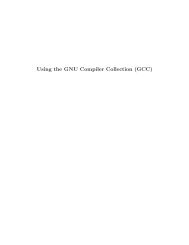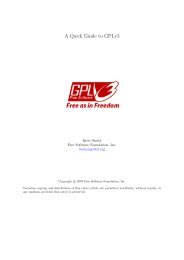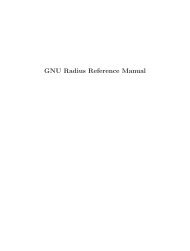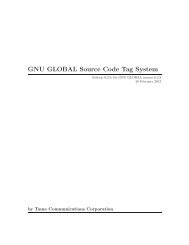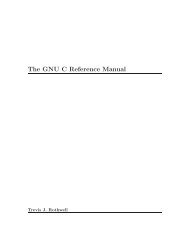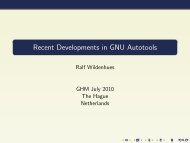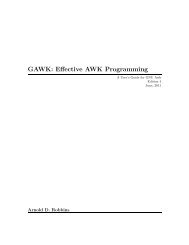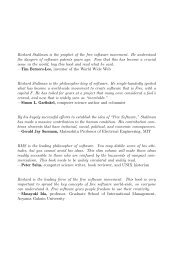by Trent A. Fisher and Werner Lemberg - The GNU Operating System
by Trent A. Fisher and Werner Lemberg - The GNU Operating System
by Trent A. Fisher and Werner Lemberg - The GNU Operating System
Create successful ePaper yourself
Turn your PDF publications into a flip-book with our unique Google optimized e-Paper software.
2 <strong>The</strong> <strong>GNU</strong> Troff Manual<br />
Doug McIllroy rewrote an extended <strong>and</strong> simplified version of roff in the<br />
BCPL programming language.<br />
In 1971, the UNIX developers wanted to get a PDP-11, <strong>and</strong> to justify the<br />
cost, proposed the development of a document formatting system for the<br />
AT&T patents division. This first formatting program was a reimplementation<br />
of McIllroy’s roff, written <strong>by</strong> J. F. Ossanna.<br />
When they needed a more flexible language, a new version of roff called<br />
nroff (“Newer roff”) was written. It had a much more complicated syntax,<br />
but provided the basis for all future versions. When they got a Graphic<br />
<strong>System</strong>s CAT Phototypesetter, Ossanna wrote a version of nroff that would<br />
drive it. It was dubbed troff, for “typesetter roff”, although many people<br />
have speculated that it actually means “Times roff” because of the use<br />
of the Times font family in troff <strong>by</strong> default. As such, the name troff is<br />
pronounced ‘t-roff’ rather than ‘trough’.<br />
With troff came nroff (they were actually the same program except<br />
for some ‘#ifdef’s), which was for producing output for line printers <strong>and</strong><br />
character terminals. It understood everything troff did, <strong>and</strong> ignored the<br />
comm<strong>and</strong>s which were not applicable (e.g. font changes).<br />
Since there are several things which cannot be done easily in troff, work<br />
on several preprocessors began. <strong>The</strong>se programs would transform certain<br />
parts of a document into troff, which made a very natural use of pipes in<br />
UNIX.<br />
<strong>The</strong> eqn preprocessor allowed mathematical formulæ to be specified in<br />
a much simpler <strong>and</strong> more intuitive manner. tbl is a preprocessor for formatting<br />
tables. <strong>The</strong> refer preprocessor (<strong>and</strong> the similar program, bib)<br />
processes citations in a document according to a bibliographic database.<br />
Unfortunately, Ossanna’s troff was written in PDP-11 assembly language<br />
<strong>and</strong> produced output specifically for the CAT phototypesetter. He<br />
rewrote it in C, although it was now 7000 lines of uncommented code <strong>and</strong><br />
still dependent on the CAT. As the CAT became less common, <strong>and</strong> was no<br />
longer supported <strong>by</strong> the manufacturer, the need to make it support other<br />
devices became a priority. However, before this could be done, Ossanna died<br />
<strong>by</strong> a severe heart attack in a hospital while recovering from a previous one.<br />
So, Brian Kernighan took on the task of rewriting troff. <strong>The</strong> newly<br />
rewritten version produced device independent code which was very easy for<br />
postprocessors to read <strong>and</strong> translate to the appropriate printer codes. Also,<br />
this new version of troff (called ditroff for “device independent troff”)<br />
had several extensions, which included drawing functions.<br />
Due to the additional abilities of the new version of troff, several new<br />
preprocessors appeared. <strong>The</strong> pic preprocessor provides a wide range of<br />
drawing functions. Likewise the ideal preprocessor did the same, although<br />
via a much different paradigm. <strong>The</strong> grap preprocessor took specifications<br />
for graphs, but, unlike other preprocessors, produced pic code.



